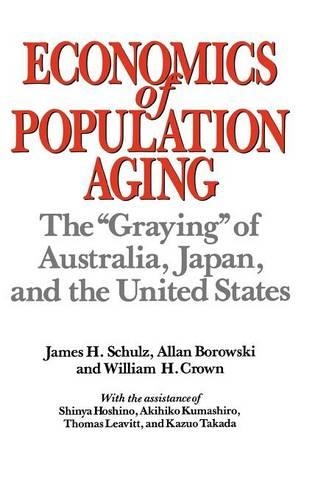
Economics of Population Aging: The Graying of Australia, Japan, and the United States
(Hardback)
Publishing Details
Economics of Population Aging: The Graying of Australia, Japan, and the United States
By (Author) Allan Borowski
By (author) William H. Crown
By (author) James H. Schulz
Bloomsbury Publishing PLC
Praeger Publishers Inc
17th October 1990
United States
Classifications
Tertiary Education
Non Fiction
Care of the elderly
Public finance and taxation
362.6
Physical Properties
Hardback
384
Description
This study examines claims that ageing populations will create serious economic problems for various nations. It examines the question in large part through the eyes of researchers and legislators in three target countries: Australia, Japan, and the United States. These countries were chosen because of similar states of economic development and because all were experiencing a rapid ageing of their populations. A comprehensive overview is provided of the economic issues related to ageing populations. Several aspects are explored in more depth. After a brief review of the phenomenon of demographic ageing, the authors give a summary of the major economic programmes offered to the aged. Extensive research is used to evaluate the concept of dependency ratios and to predict the impact on younger and older persons of future economic and demographic growth. This discussion then provides the basis for a review of evolving retirement policies in the three countries. Special attention is given to the way pension plans have been designed, especially early and mandatory retirement policies. An assessment of the adequacy of retirement income follows. The final three chapters are devoted to policy options for the future, given trends in demographic ageing. Social scientists and economists will be most interested in this study.
Reviews
The 'graying' of the population is a topic that has received much public and media attention of late. The discussion is usually framed in the context of the US, and the prognosis is not very favorable for those who must support the increasing 'burden.' The authors show that, when looked at more fully, the problem is less serious and the welfare costs less dramatic than one would be led to believe. They provide a detailed analysis of the changing demographics for three countries--Australia, Japan, and the US. Not only are the numbers reported, but they are rigorously analyzed. Dependency ratios, for example, are adjusted both for older and younger groups, and the relative effects of each group are counted in assessing the burden of the aged. The intercountry comparisons are of special interest and make this book a unique contribution to the literature. The authors' conclusions are substantiated with empirical data, and the arguments are reasonable and cogent. The level of economic analysis would be comprehensible by students with little formal training in economics. Detailed bibliography, broken down by topic. The work would be of interest to policymakers, sociologists, gerontologists, and demographers as well as economists.-Choice
"The 'graying' of the population is a topic that has received much public and media attention of late. The discussion is usually framed in the context of the US, and the prognosis is not very favorable for those who must support the increasing 'burden.' The authors show that, when looked at more fully, the problem is less serious and the welfare costs less dramatic than one would be led to believe. They provide a detailed analysis of the changing demographics for three countries--Australia, Japan, and the US. Not only are the numbers reported, but they are rigorously analyzed. Dependency ratios, for example, are adjusted both for older and younger groups, and the relative effects of each group are counted in assessing the burden of the aged. The intercountry comparisons are of special interest and make this book a unique contribution to the literature. The authors' conclusions are substantiated with empirical data, and the arguments are reasonable and cogent. The level of economic analysis would be comprehensible by students with little formal training in economics. Detailed bibliography, broken down by topic. The work would be of interest to policymakers, sociologists, gerontologists, and demographers as well as economists."-Choice
Author Bio
JAMES H. SCHULZ is Professor of Economics in the Florence Heller School at Brandeis University. He holds the Meyer and Ida Kirstein Chair in Aging Policy and is a former president of the Gerontological Society of America. His other books include Providing Adequate Retirement Income and The Economics of Aging (Auburn House). ALLAN BOROWSKI is in charge of research at the Australian Bureau of Immigration Research and is an Associate of the Lincoln Gerontology Centre in Melbourne. He has been a consultant to numerous welfare agencies in Australia, the United States, and Canada. He is the author of over 50 publications in the areas of youth, pensions, employment, and social security. WILLIAM H. CROWN is Associate Research Professor at the Policy Center on Aging in the Florence Heller School at Brandeis University. He is an economist specializing in regional economics and the economics of aging. He is especially well-known for his articles on changing demographic trends and their economic impact.
